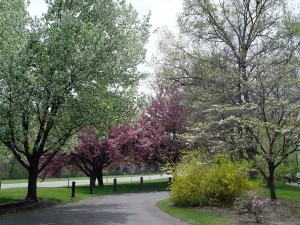Plants on Fast-Forward
April 15th, 2010
For a season that seemed like it was taking forever to get here, we’re suddenly pretty far along.
The sustained warm spell has pushed blooms, bugs and plant growth at least a couple of weeks ahead of where we’d normally be. I’m seeing lilacs blooming already, buds nearing bloom on rhododendrons and even crape myrtles leafing out.
That’s not a problem so long as Mother Nature doesn’t decide to do a sudden about-face and go way down below normal. A sub-freezing nosedive can do more harm to flower and fruiting buds when development is farther along than it ought to be.
There’s really not a whole lot we can do about it if that happens. You can cover a few tender plants with floating row covers or light blankets, but you can’t blanket the whole yard.
The Liquid Fence Co. last year debuted a supposed frost-protecting spray called FreezePruf that’s in a few stores. The claims say it can give you up to 9 degrees of protection. I tried it last fall when frosts were on the way, and I really didn’t notice any difference between how fast treated vs. untreated plants croaked.
A better strategy is to wait just a little while longer to plant those frost-wimpy annuals and tender veggies like tomatoes, peppers and eggplants. I know it’s tempting when the days are sunny and in the 70s. It seems like we’re already having May.
But I’ve seen the weather do enough wacky things that I don’t trust it at all. Maybe we’ll waste a chance to get a jump on the season, but I’m chicken enough to trade that for the odds that we’re at least one or two good frosts away from safety.
If you’ve been sneezing like it’s May and seeing bugs and bees earlier than usual, you’re not imagining things. All of nature takes cues from the weather, and when that speeds up, so does insect development, bud formation, pollen drop and so on.
There’s actually a science devoted to making those connections called “phenology.” If you’ve ever heard anyone talk about “growing degree days,” that’s a running measure of how far along in the season we are according to a current year’s weather.
I did a column on this several years ago. It’s pretty fascinating stuff. Check it out here: https://georgeweigel.net/favorite-past-garden-columns/the-bug-bloom-connection.
You’ll find that some of those supposed old wive’s tales about “planting corn when the oak leaves are the size of a squirrel’s ear” really do have some basis in fact.








